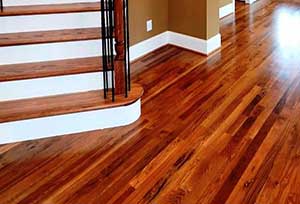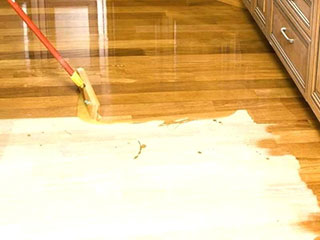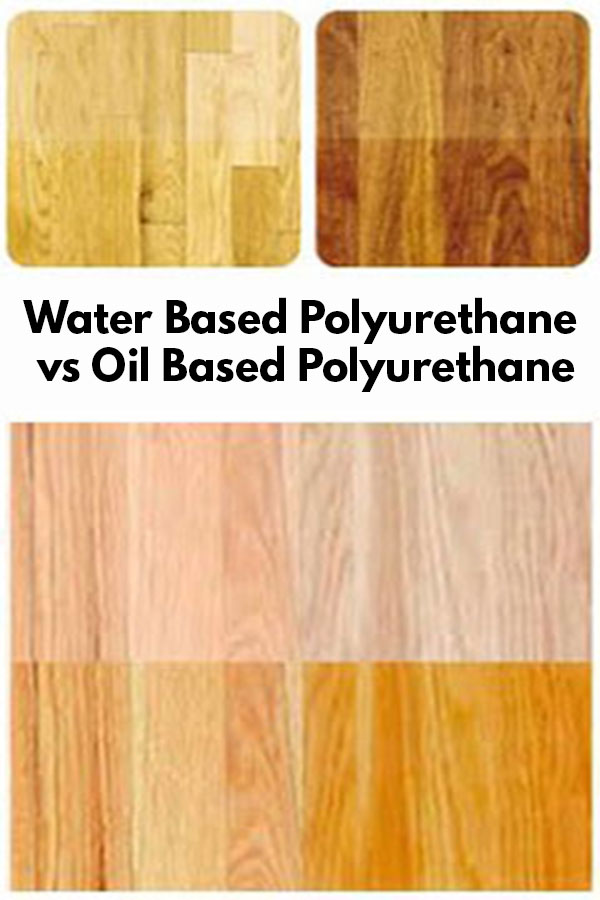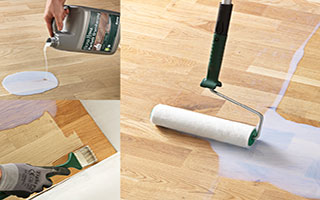 Applying polyurethane adds a protective coat to wood floors. It guards against scuffs, scratches, dents & moisture. There’s two types of polyurethane – oil based & water based. How do they compare and which floor finish is best for your application ?
Applying polyurethane adds a protective coat to wood floors. It guards against scuffs, scratches, dents & moisture. There’s two types of polyurethane – oil based & water based. How do they compare and which floor finish is best for your application ?
To make a long answer short, the main consideration is do you want to change the color of the wood by using oil based ? And if so, can you clear everyone out of the place for at least a few days, and will you be able to tolerate any residual odor ? (jump to summary for a quick overview of differences)
Durability of Water Based vs Oil Based Polyurethane
There’s an ongoing debate over which is more durable & long lasting. Some still insist that durability is the main deciding factor between water based & oil based polyurethane. Oil based used to be unquestionably more durable. Today though, water based polyurethane has evolved with better formulations that are equally durable as oil based polyurethane. High quality water based polyurethanes is considered by many homeowners & flooring professionals to be equally durable. Oil based poly can last around 10 years. Water based poly can have the same longevity. The key is using high quality water based poly like Bona Traffic and having it applied by a professional. Water and oil based polyurethane products can vary widely in quality according to the amount of actual polyurethane in the product. Higher quality products contain more polyurethane which give longer lasting durability. Going for the cheaper water based products will likely result in less durabilty & longevity.
Cost of Water Based vs Oil Based
The cost difference between the two can be significant if just looking at the price of the polyurethane itself. Quality water based polyurethane can cost 2-3x that of oil based. However with oil based, because of the added dry time requiring repeat visits, the contractors’ price is often about the same for both. So really price is not a significant deciding factor either unless you’re doing it yourself. In that case oil based would be best because water based is recommended only for professionals. Due to it’s fast drying time water based must be quickly applied & is difficult to correct mistakes. Done improperly can result with bubbles & overlapping lines.
Drytime, VOC’s & Odor of Water Based vs Oil Based
The three main differences between oil based & water based are the effect on the wood color, the drying time & odor from VOC’s. Homeowners usually have more of a choice between the two considering the odor with oil based. Oil based has a high level of VOC fumes & longer drying time. It can take 3-5 days to apply 2-3 coats & let it dry. During this time there will be high exposure to toxic fumes. Because of this many apartment & condo buildings do not even allow oil based. Fumes can permeate throughout a building, effecting many people.
For homeowners oil based floor finish is an option if you can afford to vacate everyone from the house during this time. Upon return you may need to keep windows open & fans on for some days. The odor can also settle into curtains, rugs, bedding & clothing. It can even take up to a couple months for the odor to not effect persons with asthma & various sensitivities. If you are planning to apply oil based yourself consider that you will need a respirator for protection against the noxious fumes.
Water based polyurethane does not require using a respirator or vacating everyone. It is not completely odorless, but very low odor & safe to use while the area is occupied. Due to it’s fast drying time all the coats can be applied in the same day. It does take 7 days to fully cure but can be walked on after 24 hours and furniture may be carefully replaced after 3 days. This is the recommendation for Bona Traffic, others may vary. (For Bona Traffic, Bona states “The curing process takes approximately 7 days, (75% cured after 1 day, 90% after 3 days). The floor may be walked on after 24 hours but remains susceptible to scuffing or marring until completely cured. Furniture can be moved back in carefully after 3 days. Do not replace area rugs until the floor has fully cured.”)
Wood Color Change – Water Based vs Oil Based Polyurethane
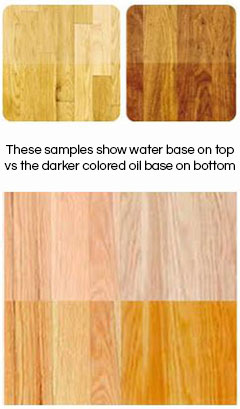 The effect on the color of the wood is the other main difference between water & oil based. Water based doesn’t change the wood color, it dries clear & remains clear so wood keeps it’s natural color. This is especially better for certain types of wood where you don’t want to alter the color like gray, white & lighter wood which looks better with a clear finish. Oil based floor finish goes well with wood that has darker or yellowish tones. It will add an amber tone which will darken more over time. It’s a matter of preference, some see the color change as an enhancement. This image shows wood samples with the lighter water based on top & darker oil based on bottom.
The effect on the color of the wood is the other main difference between water & oil based. Water based doesn’t change the wood color, it dries clear & remains clear so wood keeps it’s natural color. This is especially better for certain types of wood where you don’t want to alter the color like gray, white & lighter wood which looks better with a clear finish. Oil based floor finish goes well with wood that has darker or yellowish tones. It will add an amber tone which will darken more over time. It’s a matter of preference, some see the color change as an enhancement. This image shows wood samples with the lighter water based on top & darker oil based on bottom.
Both types of poly can give a great result though. When high quality product is properly applied, both will give a finish that’s smooth on the feet & has long lasting durability. But whether it’s oil or water based, longevity will still depend on preventative care & maintenance. Use throw rugs in high traffic areas, put felt pads on furniture legs, remove grit regularly by sweeping or vacuuming, keep pet nails trimmed, avoid high heels on floor & best yet remove shoes.
Summary Comparison of Water based vs Oil Based Polyurethane:
Color:
water based: doesn’t change color of wood, dries clear and stays clear. Ideal for light colored wood.
oil based: darkens the color of wood adding yellowish tone, amber tone continues to darken over time. More suited for dark color wood.
Shine:
water based: less shine
oil based: more shine
Required coats:
water based: 3 coats of high quality product like Bona Traffic, 4-5 coats of lower quality product
oil based: 3 coats
Dry time:
water based: 2-3 hours between coats, 24 hours to walk on, 72 hours to replace furniture, a total of 4 days (but house can remain occupied)
oil based: one coat a day can be applied, 24 hours to walk on, 48 hours to replace furniture, a total of 5 days.(house must be vacated at least 3 days)
Ease of application:
water based: not easy, requires experience, not recommended for do it yourself because it dries quick & can leave bubbles & overlapping lines, difficult to correct mistakes
oil based: easier to do it yourself, the extended dry time allows time to apply evenly & correct mistakes
Odor/VOC’s:
water based: very low odor & VOC’s compared to oil based, area can be safely occupied during application, much more environmentally friendly
oil based: very strong odor & high VOC’s during application, area must be vacated for at least a few days, odor can linger for days or weeks, requires a respirator to apply
Cost:
water based: quality product can cost 2-3x that of oil based, but because of oil based extended dry time requiring additional trips, contractor prices are often the same whether water or oil based.
oil based: less expensive for the product itself which can save money if you’re doing it yourself
Clean up:
water based: water & soap
oil based: mineral spirits, paint thinner or turpentine
Durability:
water based: can last around 10 years when high quality product is applied by professionals, inexpensive lower quality product may last only 5-6 years. Water based is harder which offers greater dent resistance.
oil based: generally lasts around 10 years. Oil based is softer which can offer greater scratch resistance.
As a professional flooring company in New York City our #1 choice for polyurethane is the water based Bona Traffic line. Most buildings in the city do require water based because of the oil based toxic odors. However many customers also prefer water based for the above mentioned reasons. In Long Island where we service houses we do have occasional requests for oil based, though water based still is most preferred. We have many satisfied customers and you can see our reviews here for Gemini Floor Services. (Read more about water based polyurethane) Choosing the right stain and finish.
